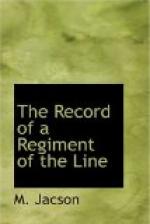The gallant conduct of Colour-Sergeant Palmer was brought to notice under the following circumstances: When three companies of the Regiment were ordered to charge the ridge held by the enemy on Wagon Hill on January 6th, 1900, Colour-Sergeant Gilbert Palmer was with the leading company, and he at once dashed out to the front with most conspicuous bravery, and went straight for the point from which the heaviest fire was coming. The enemy ran before they were reached, but the three companies were exposed to a galling fire from the right, left, and front. Colour-Sergeant Palmer got behind a rock and shot several of the enemy, at the same time keeping a constant eye upon his own men, telling them when and where to fire, and when to take cover. When all the company officers were either killed or wounded, he at once recognized his position as senior non-commissioned officer, and was invaluable in getting orders passed to the other companies, and in superintending the men till dark, when the enemy retired. He then, acting under orders, personally placed the outpost line, saw to the collection of the dead and wounded, and, in fact, rendered invaluable assistance in every way.
His dash and pluck during the bayonet charge, his coolness and steady courage under a heavy cross fire, and the power of command and of quick and correct judgment displayed by him were most brilliant. Colour-Sergeant Palmer’s name was previously brought to notice for gallant conduct at the battle of Elandslaagte on October 21st, 1899, so that this made the second occasion on which he conspicuously distinguished himself.
The names of the following non-commissioned officers and men were also brought to notice for gallantry on the occasion:—
Lance-Corporal Gilbert Young.
" " Frank John Rowe.
Private Henry Brimmicombe.
" R.G. Hansford.
" E. Norman.
" H. Cox.
The following message from Her Majesty the Queen was received by Sir George White for promulgation:—
“To Sir George White,
“Ladysmith.
“Warmly congratulate you and all under your command on your brilliant success. Greatly admire conduct of Devonshire Regiment.
V.R.I.”
The following telegram was also received:—
“O/C Devon Regiment,
“Railway Cutting.
“G.O.C. directs me to convey direct to you the following message from Sir R. Buller:—
“’Congratulate all troops on gallant defence, especially Devon Regiment.’”
The losses sustained by the garrison of Ladysmith on the 6th January were:—
Killed. Wounded.
Officers 18 25
Men 150 224
Total killed and wounded, 417.
By the death of Captain Lafone the Regiment lost one of the kindest-hearted and best officers that ever led a company.
The Boers’ losses are estimated at 64 killed and 119 wounded. This estimate may be considered low, for the Standard and Diggers’ News, copies of which were found later on in the war, gave six full-length columns of killed and wounded amongst the various commandos.




